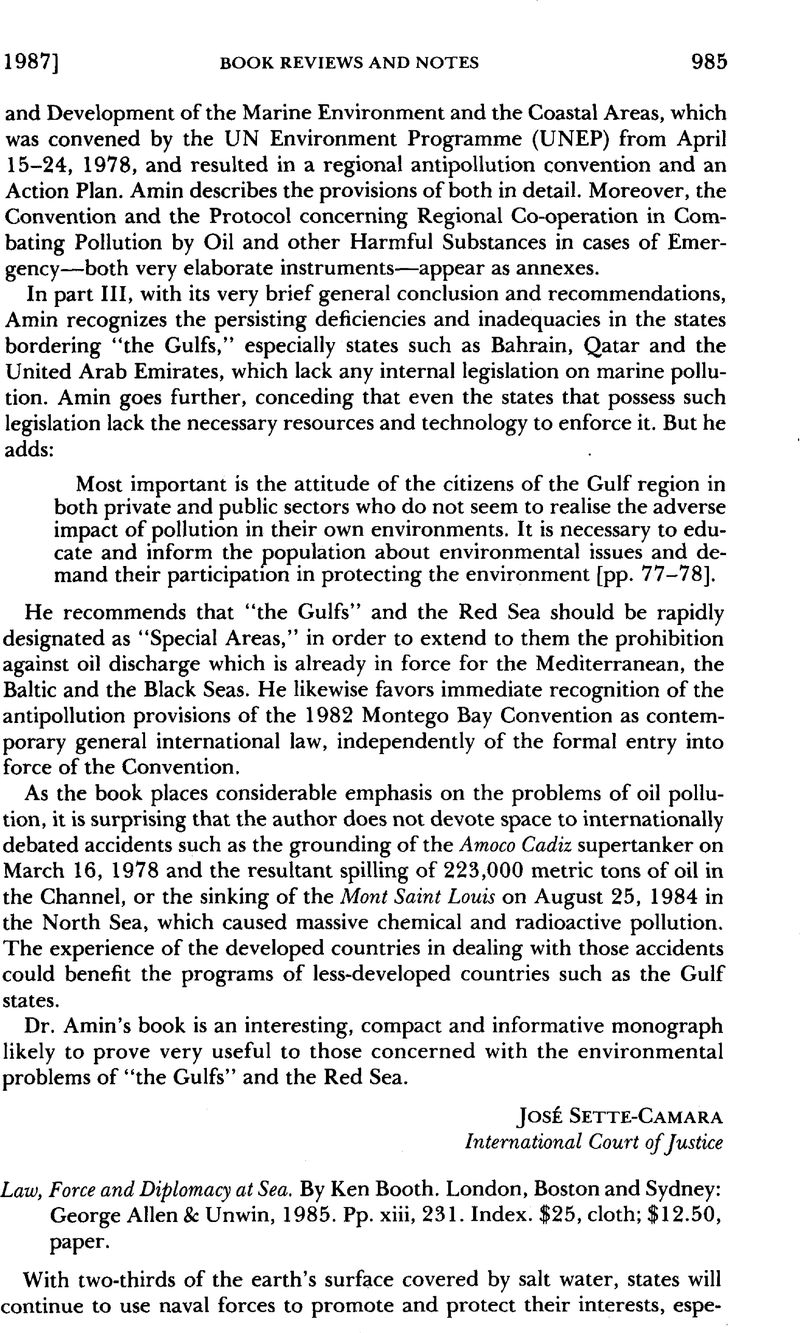No CrossRef data available.
Article contents
Law, Force and Diplomacy at Sea. By Ken Booth. London, Boston and Sydney: George Allen & Unwin, 1985. Pp. xiii, 231. Index. $25, cloth; $12.50, paper.
Published online by Cambridge University Press: 27 February 2017
Abstract

- Type
- Book Reviews and Notes
- Information
- Copyright
- Copyright © American Society of International Law 1987
References
1 See Hollick, A., U.S. Foreign Policy and the Law of the Sea 144–47 (1981)Google Scholar.
2 See Allison, , The Soviet Union and UNCLOS III: Pragmatism and Policy Evolution, 16 Ocean Dev. & Int’l L. 109 (1986)CrossRefGoogle Scholar.
3 Secretary of Defense Caspar W. Weinberger states U.S. policy as follows:
Freedom of navigation has been critically important to the world community since man began traveling the seas . . . . For these reasons, the United States and most other countries must deny any excessive claims to waters made by any nation . . . . To show that we do not recognize such claims, we have conducted freedom-of-navigation exercises many times in many places around the world—in international waters off countries both friendly and hostile. Since this program was instituted in 1979, many of the 90 countries with excessive claims have been challenged.
SECDEF OPED, L.A. Times, Mar. 30, 1986, at 5, col. 1.
4 For a comprehensive discussion including some thoughts on political will and national priorities, see Oxman, , The Regime of Warships under the United Nations Convention on the Law of the Sea, 24 Va. J. Int’l L. 809 (1984)Google Scholar.
5 A more recent example is the 1986 incident in which F–111 s from England threaded the needle over the Strait of Gibraltar to join carrier aircraft in a U.S. attack on Libyan facilities. The circuitous ocean flight, supported by numerous tankings, was necessary because permission to overfly sovereign territories had not been forthcoming.
6 A major objective in support of U.S. interests is “to assure unimpeded U.S. access to oceans and space.” National Security Strategy of the United States, The White House, June 1987.
7 For a full discussion, see Robertson, , Passage Through International Straits: A Right Preserved in the Third United Nations Conference on the Law of the Sea, 20 Va. J. Int’l L. 801 (1980)Google Scholar.
8 For a comprehensive treatment, see Robertson, , Navigation in the Exclusive Economic Zone, 24 id. at 865 (1984)Google Scholar.
9 Report of the Secretary of Defense to the Congress on the FY 86 Budget, FY 1987 Authorization Request and FY 1986–90 Defense Programs 153 (1985).
10 The positioning of an aircraft carrier battle group in the northern Arabian Sea because of the military threat to international shipping is a recent, but typical, example. Wash. Post, Aug. 28, 1987, at A19, col. 3.
11 See Truver, , The Law of the Sea and the Military Use of the Ocean in 2010, 45 LA. L. Rev. 1221 (1985)Google Scholar.
12 President’s Ocean Policy Statement (U.S. EEZ Proclamation) of Mar. 10, 1983, 48 Fed. Reg. 10,605 (1983). See also Current Development, Exchange Between Expert Panel and Reagan Administration Officials on Non-Seabed-Mining Provisions of LOS Treaty, 79 AJIL 151 (1985).




